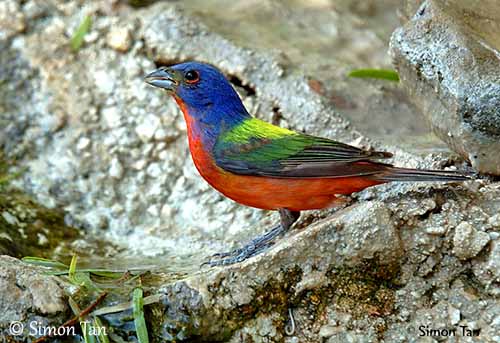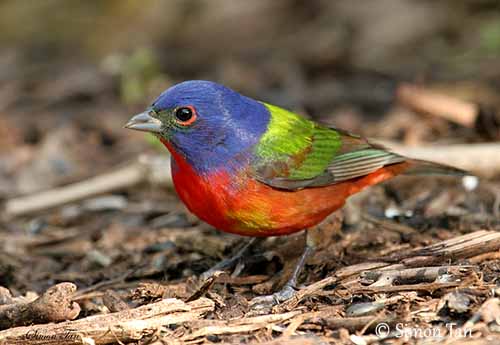
Fr: Passerin nonpareil
All: Papstfink
Esp: Azulillo Sietecolores
Ita: Papa della Luisiana
Nd: Purpergors
Sd: Påvefink
Photographer:
Simon Tan
PBase Bird galleries
Text by Nicole Bouglouan
Sources:
HANDBOOK OF THE BIRDS OF THE WORLD Vol 16 by Josep del Hoyo- Andrew Elliot-David Christie – Lynx Edicions – ISBN: 9788496553781
A GUIDE TO THE BIRDS OF MEXICO AND NORTHERN CENTRAL AMERICA by Steve N. G. Howell, Sophie Webb - Oxford University Press - ISBN: 0198540124
FIELD GUIDE TO THE BIRDS OF NORTH AMERICA - National Geographic Society - ISBN: 0792274512
L’ENCYCLOPEDIE MONDIALE DES OISEAUX - Dr Christopher M. Perrins - BORDAS - ISBN: 2040185607
BirdLife International (BirdLife International)
All About Birds (Cornell Lab of Ornithology)
Animal Diversity Web (University of Michigan Museum of Zoology)
Neotropical Birds – Cornell Lab of Ornithology
What Bird-The ultimate Bird Guide (Mitchell Waite)
Wikipedia, the free encyclopaedia
Painted Bunting
Passerina ciris
Passeriformes Order – Cardinalidae Family
INTRODUCTION:
This genus was formerly in the family Emberizidae, subfamily Cardinalinae, and some authors still place this genus in this family. But it is included now in the family Cardinalidae, with several other brightly coloured birds with more or less heavy, conical bill. They are usually found in the forested areas of Middle America, from SW USA, S to South America, N and W of the Andes.
With such bright coloured plumage, the Painted Bunting is one of the most beautiful American songbirds!
DESCRIPTION OF THE BIRD:
Biometrics:
Length: 12-13 cm
Wingspan: 20-22 cm
Weight: 13-19 g
The Painted Bunting adult male has yellow green back and red rump. Wings and tail are darker, with median coverts bordered with reddish, and greater coverts edged green. The scapulars are reddish-brown.
The underparts are red, including chin and throat.
The head is blue, including forehead, face, crown, neck sides and nape. The eyes are black with red eyering. The conical bill is greyish. Legs and feet are greyish brown.

The female has greenish upperparts and head, and pale eyering. The underparts are yellower, tinged olive on breast and flanks.
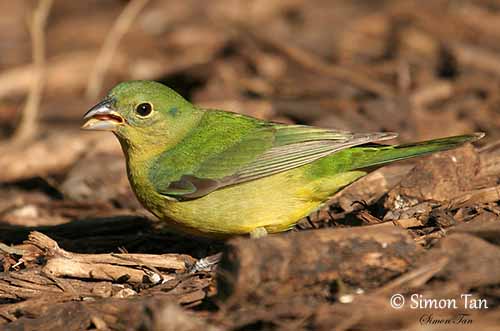
The juvenile resembles adult female with indistinct streaks on duller underparts, and narrow buff lower wingbars.
The first year female is duller and browner on upperparts, and dull yellow on underparts.
The first year male is brighter than the young female, and shows a few blue and red feathers in spring.
The young bird needs one year to obtain the full adult plumage. A rich coloured plumage indicates a tropical species.
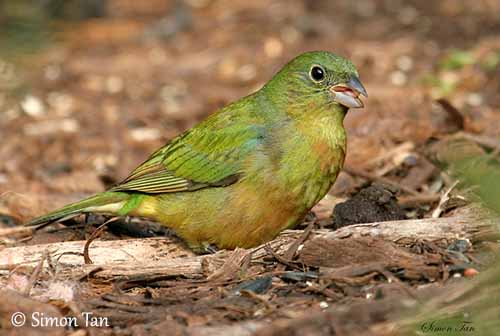
SUBSPECIES AND RANGE:
There are two subspecies.
P.c. ciris (here described) breeds along Atlantic coast from North Carolina to North Central Florida. It winters in Florida, Bahamas and sometimes Cuba.
P.c. pallidior breeds in southern United States and north-eastern Mexico. It winters from Mexico to central Panama.
This race is larger and paler than nominate, but there are several individual variations.
HABITAT:
The Painted Bunting frequents bushy and weedy fields, woodland edges, streamside brush, arid to semi-humid, semi-open areas with edges and recently abandoned farmland.
It winters in shrubby pastures, forest edges and clearings and other similar habitats. It can be seen from sea-level up to 1400/1800 metres of elevation according to the range.
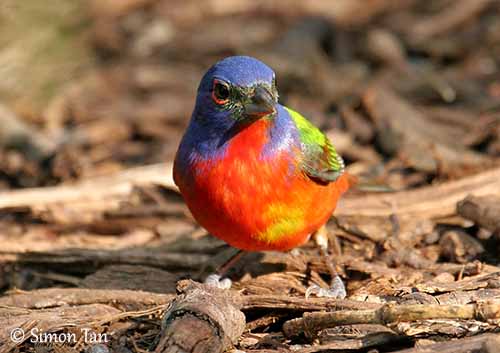
CALLS ANS SONGS:
The Painted Bunting’s call is a sharp “chirp” or a loud, rich “chip”, also “plik” or “pik-pik-pik”.
The song is a rapid series of varied phrases, a musical series of notes, and a rich warbler. Only the male sings.
BEHAVIOUR IN THE WILD: SOUNDS BY XENO-CANTO
The Painted Bunting feeds mainly on seeds and insects, also caterpillars, beetle larvae, grasshoppers, spiders and snails.
This species is shy, often skulking into the vegetation. It feeds on seeds on the ground, among weedy cover or under bushes. It is difficult to see, despite its bright colours. It sometimes frequents bird-feeders. It may grab tall grass stems in the bill to pull them to the ground, in order to extract the seeds. It may also pick insects from spider’s webs.
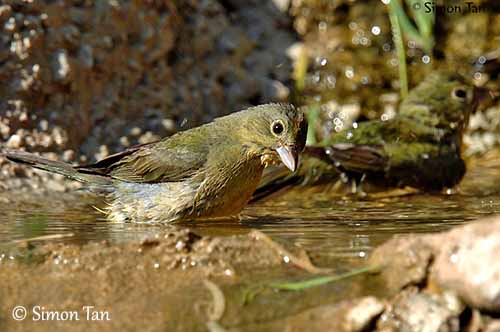
Outside the breeding season, it is often seen singly or in small flocks, on or near the ground. It may join mixed foraging flocks while they are feeding on seeds.
The male arrives first at the breeding grounds, one week before females, in order to select and defend a mating territory.
It sings during the breeding season from an exposed perch. At this time, it is easier to observe this nice bird. It defends the territory by singing. It fights to hold its territory, but these fights may be bloody, and even fatal, including pecking, beating with wings and grappling.
The Painted Buntings are usually monogamous, but polygyny is not uncommon and several males may have more than one mate. They remain solitary or in pairs during the breeding season. The mating period involves some visual displays such as upright display, body-fluff display, bow display and wing-quivering display.
The Painted Bunting performs frantic fluttering and utters alarm calls when threatened.
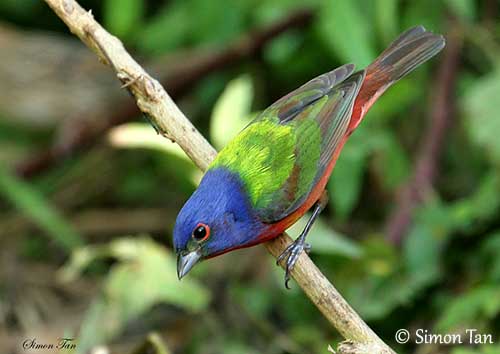
This species is almost totally migratory, leaving its breeding grounds to winter southwards. They are nocturnal migrants. Some populations may winter in extreme S Louisiana and SE Texas, but in this case, breeding and wintering areas do not overlap.
The Painted Bunting performs short flights with rapid wing beats. It may have unique flight patterns, such as “butterfly flights”, with slow undulating flight with deep wing beats, and “moth flights”, with slow descending flight with wing-quivering display. These displays are performed by the males.
REPRODUCTION OF THIS SPECIES:
The breeding season occurs from late March to early August, with peak from mid-May to mid-July.
The Painted Bunting’s nest is built near the ground in a bush, or in a fork of small tree, between 50 cm and 3 metres above the ground. The nest is cup-shaped and made with grass stems, rootlets and bark strips. It is lined with moss and hair. It is made by the female.
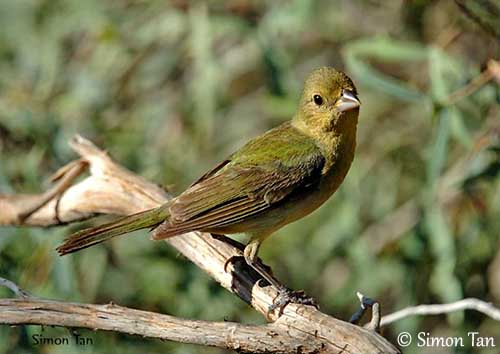
She lays 3-4 bluish-white to greyish-white eggs with dense darker markings. The incubation lasts about 11 to 12 days, by the female alone. The altricial chicks are fed by the female, and occasionally by the male. They fledge 12-14 days after hatching. The parental care may last about three weeks after fledging.
This species usually produces two broods, sometimes three per season, separated by one month.
The nests are frequently parasitized by Brown-headed Cowbirds and Bronzed Cowbird. The western population has developed some defences and abandon the parasitized nests.
PROTECTION / THREATS / STATUS:
The Painted Buntings have two distinct breeding populations, but their decline began 35 years ago, probably with habitat loss, but also cowbird parasitism.
This beautiful coloured bird is very popular as cage bird, and in Mexico and Central America, thousands are trapped each year for export in Europe.
The Painted Bunting has also nest and egg predators such as different snake species.
But recent studies in the Carolinas indicate that decline could be slowing in both states.
However, this species is classified as Near Threatened.
